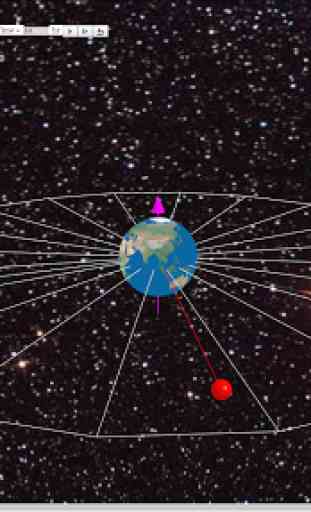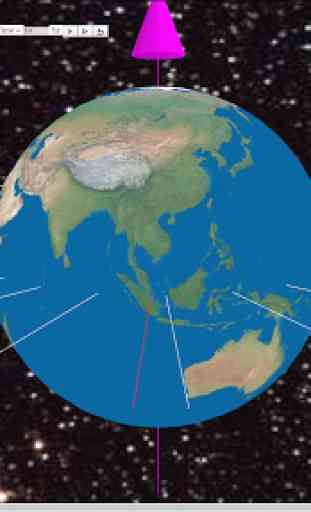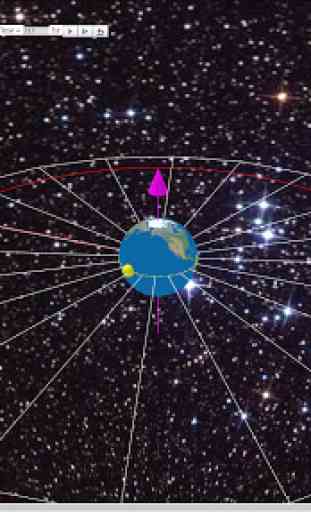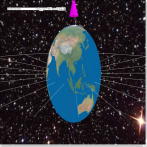Geostationary Orbit 3D Lab
AboutAn open source physics at Singapore simulation based on codes written by Francisco Esquembre and Loo Kang WEE.more resources can be found herehttp://iwant2study.org/ospsg/index.php/interactive-resources/physics/02-newtonian-mechanics/08-gravity
IntroductionA geostationary (Earth) satellite is a satellite that rotates around Earth in a certain orbit such that it is always positioned above the same point on the Earth’s surface. Hence from the point of view of an observer standing at that point, the geostationary satellite appears to be always ‘stationary’ above him/her (but actually, both observer and satellite are rotating at the same angular speed). In order for a satellite to be moving in such a geostationary orbit, there are certain conditions to meet:
placed vertically above the equatorsame directional sense as the rotation of the Earth (determine through axis of rotation)same orbital period of Planet, in our case, Earth, thus the orbital period of approximately 24 hrs
The simulation has a Earth and a Satellite object Menu Drop Down Allows for selecting what motion of Satellite is simulated.Geostationary near SingaporeGeostationary near AfricaGeostationary near AmericaNon-geostationary due to directioncircular motion r=3*Re, T =7.30 hrcircular motion r=10.5*Re, T = 48 hrNon-Geostationary generallyUnlikely OrbitsOptions added are:Show:equator Plane, for visualising the Earth's rotating equator planeGeo stationary, for visualising a geostationary object (RED) for comparative observation with the other modes.Show text: 35 700 km fixed position of object relative to planet earth.Axes earth: show spin axes of the rotation of earth in GREENAxes satellite: show spin axes of the rotation of satellite in MAGENTAForce: pair of action reaction force of equal magnitude, opposite direction and on different bodies. (Newton's 3rd Law)
AcknowledgementMy sincere gratitude for the tireless contributions of Francisco Esquembre, Fu-Kwun Hwang, Wolfgang Christian, Félix Jesús Garcia Clemente, Anne Cox, Andrew Duffy, Todd Timberlake and many more in the Open Source Physics community. I have designed much of the above based on their ideas and insights.This research is supported by the eduLab project NRF2015-EDU001-EL021 , awarded by the Prime Minister Office, National Research Foundation (NRF), Singapore in collaboration with National Institute of Education (NIE), Singapore and the Ministry of Education (MOE), Singapore.reference:http://edulab.moe.edu.sg/edulab-programmes/existing-projects/nrf2015-edu001-el021
Network Learn together?FaceBook Fan Page: https://www.facebook.com/Open-Source-Physics-Easy-Java-Simulation-Tracker-132622246810575/Twitter: https://twitter.com/lookangYouTube: https://www.youtube.com/user/lookang/videosBlog: http://weelookang.blogspot.sg/Digital Library: http://iwant2study.org/ospsg/
IntroductionA geostationary (Earth) satellite is a satellite that rotates around Earth in a certain orbit such that it is always positioned above the same point on the Earth’s surface. Hence from the point of view of an observer standing at that point, the geostationary satellite appears to be always ‘stationary’ above him/her (but actually, both observer and satellite are rotating at the same angular speed). In order for a satellite to be moving in such a geostationary orbit, there are certain conditions to meet:
placed vertically above the equatorsame directional sense as the rotation of the Earth (determine through axis of rotation)same orbital period of Planet, in our case, Earth, thus the orbital period of approximately 24 hrs
The simulation has a Earth and a Satellite object Menu Drop Down Allows for selecting what motion of Satellite is simulated.Geostationary near SingaporeGeostationary near AfricaGeostationary near AmericaNon-geostationary due to directioncircular motion r=3*Re, T =7.30 hrcircular motion r=10.5*Re, T = 48 hrNon-Geostationary generallyUnlikely OrbitsOptions added are:Show:equator Plane, for visualising the Earth's rotating equator planeGeo stationary, for visualising a geostationary object (RED) for comparative observation with the other modes.Show text: 35 700 km fixed position of object relative to planet earth.Axes earth: show spin axes of the rotation of earth in GREENAxes satellite: show spin axes of the rotation of satellite in MAGENTAForce: pair of action reaction force of equal magnitude, opposite direction and on different bodies. (Newton's 3rd Law)
AcknowledgementMy sincere gratitude for the tireless contributions of Francisco Esquembre, Fu-Kwun Hwang, Wolfgang Christian, Félix Jesús Garcia Clemente, Anne Cox, Andrew Duffy, Todd Timberlake and many more in the Open Source Physics community. I have designed much of the above based on their ideas and insights.This research is supported by the eduLab project NRF2015-EDU001-EL021 , awarded by the Prime Minister Office, National Research Foundation (NRF), Singapore in collaboration with National Institute of Education (NIE), Singapore and the Ministry of Education (MOE), Singapore.reference:http://edulab.moe.edu.sg/edulab-programmes/existing-projects/nrf2015-edu001-el021
Network Learn together?FaceBook Fan Page: https://www.facebook.com/Open-Source-Physics-Easy-Java-Simulation-Tracker-132622246810575/Twitter: https://twitter.com/lookangYouTube: https://www.youtube.com/user/lookang/videosBlog: http://weelookang.blogspot.sg/Digital Library: http://iwant2study.org/ospsg/
Category : Education

Related searches




